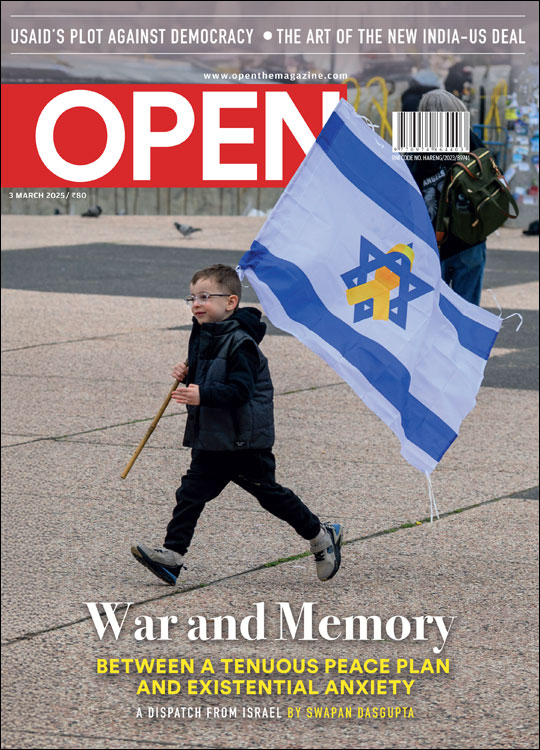The Kingdom of Khan
They have ruled Bollywood for as long as you can possibly remember. Plain coincidence?
 Shubhangi Swarup
Shubhangi Swarup
 Shubhangi Swarup
|
27 Jan, 2011
Shubhangi Swarup
|
27 Jan, 2011
/wp-content/uploads/2015/11/khans-1.jpg)
They have ruled Bollywood for as long as you can possibly remember. Plain coincidence?
Before the release of 3 Idiots, Aamir Khan came up with an unusual marketing gimmick. Since the movie was built around two friends searching for his character Rancho, Aamir would lose himself in different parts of India, and leave fans guessing where he could be. On one such trip, he announced he was off to see his mother. But instead of going to Pune, where she now lives, he went to Banaras, in search of her ancestral house. He didn’t know her maiden name. “All I knew was that the house was in a locality called Telia Nala, and the name of the house was Khwaja Manzil,” he says.
Aamir had disguised himself as an old man and had little hope of finding the house. He went to a teashop and asked for help. Suddenly, there was what he calls an entire ‘paltan’ on his side. “Somehow, in that locality, people were very helpful. They took me to all the old people; they were probably thinking ‘Inki ammi yahaan dus saal ki umar mein rehti thhin, toh bahut pehle ki baat hai (His mother lived here when she was ten—that’s a long time ago).’ I was taken to Banney miyan and Nawabsahib, who must have been 89 or so,” he says.
His mother was also on the mobile phone giving him directions. “I told her I’m in your mohalla. So she said ‘Go to the Shia masjid’.” Thrice did she guide him like this, but he couldn’t find the house. Aamir remembered her telling him that when they moved out, the house had been sold to a Sikh family. “So I asked, ‘Yahan koi Sardarji rehte hain? (Does a Sikh live here?)’ They said ‘yes’. It’s a Muslim mohalla. Only one Sardar family lives there. They took me to the house.”
Had Aamir revealed his identity, he could perhaps have enjoyed the hospitality of the current owners. A lady in the house said her husband wasn’t at home, and she looked unsettled by the sight of a strange old man with buckteeth at her doorstep. “Had I revealed who I was, she would probably have welcomed me. I just told her I wanted to see it because my mother lived here.” And then Aamir Khan quietly left.
More than a year later, while he narrates this experience, Aamir forgets the names of both the locality and house. He calls up his mother in the middle of the interview. “Ammi, main Khan bol raha hoon,” he says. Brought up in an Urdu-speaking household, his tongue sharply distinguishes the ‘kh’ of khana from the ‘kh’ of Khan. Mohammed Aamir Hussain Khan is the son of Mohammed Tahir Hussain Khan. While his father decided to shorten his name to just Tahir Hussain when he entered the film industry, his son decided to call himself Aamir Khan. “Aamir Khan felt better, sounded better,” he says.
We take it as normal for the top three superstars in Bollywood—Aamir, Salman and Shah Rukh—to share a surname. But it is extraordinary, even for a coincidence. Muslims are 13 per cent of India’s population, of which Khans are a small subset. But the coincidences don’t end there. All three were born in 1965 and all share Pathan lineage; there are Khans from other roots too. Karan Johar, an otherwise eloquent man, couldn’t quite figure out the nature of this coincidence when he had Shah Rukh Khan on his show. He called it ‘ironical’ while referring to a ‘Khan-dom’. The superstar coincidence gets better: one of the first superstars of Bollywood, Dilip Kumar, is also a Khan.
The media loves calling it the Khan dynasty, much like the Kapoor dynasty in Bollywood or Gandhi dynasty in Indian politics. But for Amrit Gangar, a film scholar who has authored several books on cinema, such a term is misleading. To look at the Khans as a clan, he says, is to think all Gandhis are related. Gangar once met a Japanese who thought Indira Gandhi was the daughter of Mahatma Gandhi. For Khans to be a dynasty in Bollywood, they would all have to be related to each other, or share other common features. But they don’t. A Khan can be Shia or Sunni. A Khan can be a nawab, like Saif Ali Khan, or he can be a poor illiterate from a village, like the director of Mother India, Mehboob Khan. Not all trace their lineage to the Pathans of Afghanistan. Khan was also a title conferred on some by the Mughals and then the British during their rule. When some Rajputs converted to Islam, several of them also took on the surname. ‘Because the Pathans were a warrior people like the Rajputs, and they were respected and feared for their bravery, the Rajputs adopted not only the title Khan but also clan names such as Yousafzais, Khattak or Afridi. It is interesting to know that the Pathans of these clans had no objection to this practice,’ writes Safia Haleem in her Study of Pathan Communities in Four States of India. Safia was once the editor of BBC World Service in Dari and Pashto, Afghanistan. She is currently writing a series of books on Pathans in India.
So diverse is the term Khan in its meaning, references and origins, that Wikipedia has more than 30 entries on the word. In Mongolian, Khan is a headman or ruler. Khan is also a river in Namibia, an administrative division in Cambodia, an English rock band from the 1970s, a villain in Marvel Comics’ Star Trek/X-Men—and, in this heterogeneous mix, also a group of Pathans originally from the North West Frontier Province (NWFP). But it is when you find that the ruling triumvirate of Bollywood has descended from this specific Pathan stock that the coincidence gets truly curious.
THE BOLLYWOOD KHAN
Khans have been in the Hindi film industry since its beginning, according to Shahab Ahmed, who is currently writing an ambitious book documenting all the Khans in the Hindi film industry. He cites the example of Mohammed Wazir Khan, who sang the popular De de Khuda ke naam pe in India’s very first talkie, Alam Ara, released in 1941. Despite his humble role of a fakir in the film, the song got him everyone’s attention, and he acted in all the three Alam Aras. “Although the Khans in the 1940s were proficient actors and music composers, they weren’t influential,” says Ahmed. “The invasion of Khans in the Hindi film industry began in the next decade, with Dilip Kumar, Madhubala and Ajit.”
The three didn’t have a Khan to their screen names, though: Dilip Kumar used to be Yusuf Khan, Madhubala was Mumtaz Jehan Begum, and Hamid Ali Khan we remember as Ajit (and usually with Mona darling). Like many of his contemporaries, Yusuf Khan adopted a name that would be more acceptable in Hindi films. Professor Rachel Dwyer, Professor of Indian Cultures and Cinema, SOAS, University of London, considers the name changing of that era an attempt at modernity. “Kumars and Kumaris were aiming at having ‘modern’ names, not marked by caste, region and sometimes by religion,” she says. “Dilip Kumar and Meena Kumari were never trying to hide their religious identities. Manoj Kumar and Ashok Kumar were doing the same thing. Today only Akshay Kumar continues this tradition.”
Other theories attribute the practice of adopting a Hindu name to post-Partition fears, fears of not gaining acceptance, if not outright persecution. The same fears that prevented K Asif from completing Mughal-e-Azam after he began shooting it in 1944. Producer Shiraz Ali, also the owner of Mahalakshmi Studios, fled to Pakistan fearing the worst. The originally proposed film didn’t feature Dilip Kumar, Madhubala or Prithviraj Kapoor. Had Shiraz Ali not abandoned it midway, one of India’s greatest films wouldn’t have been possible. The film’s theme of unrequited love had already seeped into the co-stars’ lives; they put a failed relationship behind them to act together in it.
The Pathans stand out in the crowded roster of Khans in Bollywood. They are synonymous with Afghans in the Subcontinent’s history, writes Safia Haleem. They came as invaders and traders and served in the armies of rulers. They were hired as soldiers, officers and diplomats by different rulers throughout the last few centuries. Whole clans would follow from the tribal areas of Afghanistan and settle in India. Many still live in Punjab, Uttar Pradesh, Central India, Bihar and elsewhere.
Salim Khan, scriptwriter and father of Salman Khan, remembers the Afghan tribe his family historically belongs to. “It is Alakozai,” he says. “My family came to Indore 150 years ago, and worked as [part of the] cavalry in the time of the British.” Salman Khan is a fifth-generation Khan in India. While completing his MA in Indore, young Salim Khan was spotted by some producers who had come to attend a wedding in Tarachand Barjatya’s family. He then left for Bombay, where he acted in what he calls “indifferent roles” in 20-odd films before switching to scriptwriting. (In the long chain of filmi coincidences, it is Tarachand Barjatya’s grandson, Sooraj Barjatya, who gave Salim’s son Salman his first big hit, Maine Pyar Kiya.)
“The Pathan Khans are both Shia and Sunni,” says Shahab Ahmed. The Pathan tribes living near the borders of Iran were commonly Shia. Ahmed gives the example of Feroze Khan and his brothers, who are Shia. Not all Pathans are Muslim either. Prithviraj Kapoor, the patriarch of the Kapoor dynasty in Bollywood, was a Khatri Hindu from Peshawar (now in Pakistan), and a proud Pathan. So is Vinod Khanna.
A Pathan also played a serendipitous role in opening the Hindi film industry’s doors to another Khan. Mehboob Khan, the director of Mother India, was a poor, illiterate boy from a tiny village called Sarar near Vadodara in Gujarat. In Rauf Ahmed’s biography of the director, in a chapter called ‘The Big Break’, he speaks of a big Pathan security guard called Behram Shah. When Mehboob Khan ran away to Bombay for the second time, he routinely hung around the gates of Imperial Film Company. The biggest hurdle here was Behram Shah, who guarded the gates. Mehboob Khan befriended the man, who eventually introduced him to the boss of the company. Mehboob Khan got a job as a film extra.
Most biographies of Shah Rukh Khan begin with romantic descriptions of Qissa Khawani Bazaar (‘the Street of Storytellers’). It is a market in Peshawar, one that Sir Edward Herbert, a British commissioner of Peshawar, called the ‘Piccadilly of Central Asia’. In Anupama Chopra’s biography of the actor, she writes how Peshawar is perched on a historical, religious and geographical crossroads, thanks to its location to the east of the Khyber Pass. Travellers would enjoy the local green tea and exchange stories in the Street of Storytellers. ‘It is fitting that some of Indian cinema’s biggest names, whose stories have seduced generations, trace their roots to this place,’ she writes.
In a mohalla there called Dahkki Nal Bandi stands the house where Prithviraj Kapoor once lived, before leaving for Bombay at the age of 22. Less than five minutes away in Dooma Gulli is the house where Dilip Kumar was born.‘In 2000, when Dilip Kumar, now worshipped as a Hindi film actor, returned to this home, he wept and pointed to a crevice under the stairs where he hid the money as a child,’ writes Anupama. Within walking distance of both these homes, in a mohalla called Shahwali Qatal, is the house where Shah Rukh’s father, Meer Taj Mohammad, was born.
During the freedom struggle, the Pathans supported the Congress party, led by Khan Abdul Ghaffar Khan, also known as Frontier Gandhi. They were broadly against Partition. Shah Rukh Khan’s father was part of the Khudai Khidmatgar, says Anupama Chopra. During the Quit India Movement, he was in and out of jail for two years. Aamir Khan too has an ancestral link with freedom fighters—his grandmother was the niece of Maulana Abul Kalam Azad.
THE COINCIDENCE
Aamir Khan believes that it is just coincidence that the industry’s top three superstars are Khans. But in typical Bollywood style, it is coincidence replete with history, great timing, even irony. To give this coincidence a communal tinge would be to miss the point, believes film critic Khalid Mohamed. “There is no communal theory or public psychology,” says he.
Yet, interestingly, Mohamed remembers a conversation he once had with Manmohan Desai, maker of superhit films like Amar Akbar Anthony and Mard, which offers an indication of the general importance of Muslims to Bollywood. “I don’t know if it’s true, Manmohan Desai once told me about a ‘vote bank Muslim audience’—they go see a film twice or thrice, they are a repeat audience. Manmohan Desai was making a film where he wanted the main character to be a Jew, but since no one would understand Jews in India, he decided to make him Muslim.”
But that still does not explain why India’s Khans should become such key players in the industry. Aamir Khan says cinema is a great leveller. It doesn’t matter what your surname is, who you are related to, or what your religion is. It is an industry where Shah Rukh’s most popular alter ego is Rahul from DDLJ, Salman Khan’s is Chulbul Pandey from Dabangg, and Aamir’s is Rancho from 3 Idiots. It is an industry where Amitabh Bachchan is most famously associated with the Muslim number 786, his lucky number in Deewar and Coolie.
Khalid also remembers yet another strange Khan parallel. It was something said by Saira Banu, Dilip Kumar’s wife—if they had a son, he would’ve looked like Shah Rukh because she thought there was an uncanny resemblance between the two. Shah Rukh also greatly resembles his late father, Meer Taj Mohammad, who aspired to be an actor too. Meer Taj even made it to the sets of Mughal-e-Azam, where he was asked to stand in the line of extras, but refused to play one. He left. Shah Rukh returned decades later without any connections, and became the third Khan after Aamir and Salman had already established a foothold.
It is all quite uncanny, these Khans just keep flitting in and out of Bollywood’s history, tempting impossible connections.
The writer is greatly indebted to Shahab Ahmed for sharing his manuscript

/wp-content/uploads/2025/02/Israel.jpg)











More Columns
Passion for the Preloved Saumyaa Vohra
Mum’s the Word Kaveree Bamzai
Losers Back Home, On Top in Thailand Kaveree Bamzai